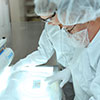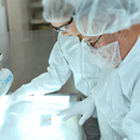K+LINE+LOGISTIS+(USA)+INC
Artikel-Nr:
(BOSSBS-1026R-CY3)
Lieferant:
Bioss
Hersteller-Artikelnummer::
BS-1026R-CY3
Lokale Artikelnummer::
BOSSBS-1026R-CY3
Beschreibung:
Desmin are class-III intermediate filaments found in muscle cells. In adult striated muscle they form a fibrous network connecting myofibrils to each other and to the plasma membrane from the periphery of the Z-line structures.
VE:
1 * 100 µl
Artikel-Nr:
(BOSSBS-1026R-CY5)
Lieferant:
Bioss
Hersteller-Artikelnummer::
BS-1026R-CY5
Lokale Artikelnummer::
BOSSBS-1026R-CY5
Beschreibung:
Desmin are class-III intermediate filaments found in muscle cells. In adult striated muscle they form a fibrous network connecting myofibrils to each other and to the plasma membrane from the periphery of the Z-line structures.
VE:
1 * 100 µl
Artikel-Nr:
(PRSI96-597)
Lieferant:
ProSci Inc.
Hersteller-Artikelnummer::
96-597
Lokale Artikelnummer::
PRSI96-597
Beschreibung:
Programmed cell death protein 1 (PD-1) is also known as CD279 and PDCD1, is a type I membrane protein and is a member of the extended CD28/CTLA-4 family of T cell regulators. PDCD1 is expressed on the surface of activated T cells, B cells, macrophages, myeloid cells and a subset of thymocytes. PD-1 has two ligands, PD-L1 and PD-L2, which are members of the B7 family. PD-L1 is expressed on almost all murine tumor cell lines, including PA1 myeloma, P815 mastocytoma, and B16 melanoma upon treatment with IFN-γ. PD-L2 expression is more restricted and is expressed mainly by DCs and a few tumor lines. PD1 inhibits the T-cell proliferation and production of related cytokines including IL-1, IL-4, IL-10 and IFN-γ by suppressing the activation and transduction of PI3K/AKT pathway. In addition, coligation of PD1 inhibits BCR-mediating signal by dephosphorylating key signal transducer. In vitro, treatment of anti-CD3 stimulated T cells with PD-L1-Ig results in reduced T cell proliferation and IFN-γ secretion. Monoclonal antibodies targeting PD-1 that boost the immune system are being developed for the treatment of cancer.
VE:
1 * 100 µG
Artikel-Nr:
(PRSI4305)
Lieferant:
ProSci Inc.
Hersteller-Artikelnummer::
4305
Lokale Artikelnummer::
PRSI4305
Beschreibung:
STEAP1 Antibody: The six-transmembrane epithelial antigen of prostate 1 (STEAP1) was the first member of a family of metalloreductases identified as cell-surface antigens in prostate tissue. The normal function of STEAP is still uncertain; unlike other members of the STEAP family, STEAP1 does not promote iron or copper reduction or uptake and lacks the FNO-like reductase domain critical for activity. However, its expression is highly increased in multiple cancer cell lines, including prostate, bladder, colon, and ovarian cancers. Supporting this is evidence that STEAP1 peptides can be used to stimulate CD8+ T cells from healthy donors, enabling them to recognize STEAP1-positive human tumor cells, suggesting that STEAP1 may a potential target for cancer immunotherapy. At least three isoforms of STEAP1 are known to exist.
VE:
1 * 100 µG
Artikel-Nr:
(PRSI7001)
Lieferant:
ProSci Inc.
Hersteller-Artikelnummer::
7001
Lokale Artikelnummer::
PRSI7001
Beschreibung:
RGS22 Antibody: Regulator of G-protein signaling (RGS) proteins contain an 120 amino acid conserved domain, termed the RGS domain, that acts as a GTPase-activating protein that acts to reduce the signal transmitted by the receptor-activated G-alpha subunit. RGS22 is a recently identified member of this family that localizes to the testis and can interact with guanine nucleotide binding proteins alpha 11, 12, and 13 (GNA11, GNA12, and GNA13). While RGS22 has been postulated to play a role in spermiogenesis in the testis, it is also expressed in several cancer cell lines with an epithelial origin and associated with cancer metastasis. Its overexpression in a highly metastatic cancer causes a decrease in cell migration and a reduction of the invasive potential of the cells, suggesting that RGS22 may be a potential prognostic biomarker for metastasis.
VE:
1 * 100 µG
Artikel-Nr:
(PRSI33-720)
Lieferant:
ProSci Inc.
Hersteller-Artikelnummer::
33-720
Lokale Artikelnummer::
PRSI33-720
Beschreibung:
Recognises a protein of 16-27 kDa, identified as human Interferon alpha 2 (IFNA2). Its epitope maps between amino acids 43-53 of the IFNA2. This mAb is specific for IFNA2 and does not cross-react with IFNA1. The epitopes of clones N27 and N39 mAbs are different and represent a good combination of antibodies to set up an ELISA assay for the quantitation of IFNA2 after viral infections. The IFNA family consists of 24 or more genes or pseudo-genes. The alpha interferons are mainly produced by lymphocytes, monocytes, macrophages, and cell lines such as Namalwa and KG1 following induction by viruses, nucleic acids, and glucocorticoid hormones. They are involved in virus resistance on target cells, inhibition of cell proliferation, induction of cytokines and regulation of expression of MHC class I antigens.
VE:
1 * 100 µG
New Product
Artikel-Nr:
(PRSI4299)
Lieferant:
ProSci Inc.
Hersteller-Artikelnummer::
4299
Lokale Artikelnummer::
PRSI4299
Beschreibung:
PTK7 Antibody: Protein-tyrosine kinases (PTKs) play important roles in regulating cell proliferation and differentiation during development. One member of the PTK family, PTK7, has been suggested to regulate the planar cell polarity (PCP) pathway in vertebrates and may play a role in neural convergent extension and neural tube closure. PTK7 has also been implicated in the development of cancer. Loss of PTK7 expression was seen in several melanoma cell lines and biopsies. Conversely, high-throughput analysis of acute myeloid leukemia samples showed an increased level of PTK7 expression compared to normal bone marrow and purified CD34+ cells. Multiple isoforms of PTK7 are known to exist.
VE:
1 * 100 µG
Artikel-Nr:
(PRSI2021)
Lieferant:
ProSci Inc.
Hersteller-Artikelnummer::
2021
Lokale Artikelnummer::
PRSI2021
Beschreibung:
DcR2 Antibody: Apoptosis is induced by certain cytokines including TNF and Fas ligand in the TNF family through their death domain containing receptors. TRAIL/Apo2L is a new member of the TNF family and induces apoptosis of a variety of tumor cell lines. DR4 and DR5 are the recently identified functional receptors for TRAIL, and DcR1/TRID is a decoy receptor. Another member of the TRAIL receptor family was more recently identified and designated DcR2, TRAIL-R4, or TRUNDD. DcR2 has an extracellular TRAIL-binding domain but lacks intracellular death domain and does not induce apoptosis. Like DR4 and DR5, DcR2 transcript is widely expressed in normal human tissues. Overexpression of DcR2 attenuated TRAIL-induced apoptosis.
VE:
1 * 100 µG
Artikel-Nr:
(PRSI4297)
Lieferant:
ProSci Inc.
Hersteller-Artikelnummer::
4297
Lokale Artikelnummer::
PRSI4297
Beschreibung:
PTK7 Antibody: Protein-tyrosine kinases (PTKs) play important roles in regulating cell proliferation and differentiation during development. One member of the PTK family, PTK7, has been suggested to regulate the planar cell polarity (PCP) pathway in vertebrates and may play a role in neural convergent extension and neural tube closure. PTK7 has also been implicated in the development of cancer. Loss of PTK7 expression was seen in several melanoma cell lines and biopsies. Conversely, high-throughput analysis of acute myeloid leukemia samples showed an increased level of PTK7 expression compared to normal bone marrow and purified CD34+ cells. Multiple isoforms of PTK7 are known to exist.
VE:
1 * 100 µG
Artikel-Nr:
(BOSSBS-2053R-A488)
Lieferant:
Bioss
Hersteller-Artikelnummer::
BS-2053R-A488
Lokale Artikelnummer::
BOSSBS-2053R-A488
Beschreibung:
May be implicated in the regulation of the transcription as a repressor of the transcriptional activity of E4TF1. In tumor cell lines, may induce apoptosis.
VE:
1 * 100 µl
Artikel-Nr:
(BOSSBS-2053R-A647)
Lieferant:
Bioss
Hersteller-Artikelnummer::
BS-2053R-A647
Lokale Artikelnummer::
BOSSBS-2053R-A647
Beschreibung:
May be implicated in the regulation of the transcription as a repressor of the transcriptional activity of E4TF1. In tumor cell lines, may induce apoptosis.
VE:
1 * 100 µl
Artikel-Nr:
(PRSI5739)
Lieferant:
ProSci Inc.
Hersteller-Artikelnummer::
5739
Lokale Artikelnummer::
PRSI5739
Beschreibung:
APC13 Antibody: Cell cycle regulated protein ubiquitination and degradation within subcellular domains is thought to be essential for the normal progression of mitosis. APC13 is a highly conserved component of the anaphase promoting complex/cyclosome (APC/C), a cell cycle-regulated E3 ubiquitin ligase that controls progression through mitosis and the G1 phase of the cell cycle. APC/C is responsible for degrading anaphase inhibitors, mitotic cyclins, and spindle-associated proteins ensuring that events of mitosis take place in proper sequence. The individual APC/C components mRNA and protein levels are expressed at approximately the same levels in most tissues and cell lines, suggesting that they perform their functions as part of a complex. APC13 promotes the stable association of APC3/Cdc27 and APC6/Cdc16 with the APC/C.
VE:
1 * 100 µG
Artikel-Nr:
(PRSI91-472)
Lieferant:
ProSci Inc.
Hersteller-Artikelnummer::
91-472
Lokale Artikelnummer::
PRSI91-472
Beschreibung:
Hepatocyte Cell Adhesion Molecule (HEPACAM) is a single-pass type I membrane protein that localizes to the cytoplasmic side of the cell membrane. HEPACAM includes a signal sequence (amino acid 1-33), an extracellular region (amino acid 34-240) with one Ig-like C2-type domain and one Ig-like V-type domain, a transmembrane segment (amino acid 241-261), and a cytoplasmic domain (amino acid 262 - 416). The cytoplasmic domain plays an important role in regulation of cell-matrix adhesion and cell motility. HEPACAM acts as a homodimer and dimer formation occurs predominantly through cis interactions on the cell surface. HEPACAM is involved in cell motility and cell-matrix interactions. The expression of this gene is down-regulated or undetectable in many cancer cell lines, so this may be a tumor suppressor gene.
VE:
1 * 50 µG
Artikel-Nr:
(PRSI90-519)
Lieferant:
ProSci Inc.
Hersteller-Artikelnummer::
90-519
Lokale Artikelnummer::
PRSI90-519
Beschreibung:
Interleukin-22 (IL-22), also known as IL-10 related T cell derived inducible factor (ILTIF) was initially identified as a gene induced by IL-9 in mouse T cells and mast cells. IL-22 has been shown to activate STAT1 and STAT3 in several hepatoma cell lines and upregulate the production of acute phase proteins. IL-22 is produced by normal T cells upon anti-CD3 stimulation in humans. Mouse IL-22 expression is also induced in various organs upon lipopolysaccharide injection, suggesting that IL-22 may be involved in inflammatory responses. The functional IL-22 receptor complex consists of two receptor subunits, IL-22R(CRF29) and IL-10Rbeta(CRF24), belonging to the class II cytokine receptor family.
VE:
1 * 25 µG
Artikel-Nr:
(PRSIXP-5168)
Lieferant:
ProSci Inc.
Hersteller-Artikelnummer::
XP-5168
Lokale Artikelnummer::
PRSIXP-5168
Beschreibung:
L13 inhibits proinflammatory cytokine production and stimulates antibody production. It induces proliferation in the human pre myeloid cell line TF1. IL13 has multiple effects on the differentiation and functions of monocytes and macrophages. It suppresses cytotoxic functions and induces changes in the morphology of human monocytes and in the phenotype of human monocytes and B cells by upregulating MHC class II expression. IL13 will also decrease the production of nitric oxide by activated murine macrophages, leading to impaired parasiticidal activity. Human and mouse interleukin 13 share approximately 58% amino acid sequence identity. Although human and mouse IL13 are equally active on human cells, human IL13 is much less active than mouse IL13 on mouse cells. Human IL13 and human IL4 also share approximately 30% sequence homology and have similar biological functions.
VE:
1 * 100 µG
Artikel-Nr:
(PRSI1137)
Lieferant:
ProSci Inc.
Hersteller-Artikelnummer::
1137
Lokale Artikelnummer::
PRSI1137
Beschreibung:
GFR alpha 3 Antibody: Members of the glial cell line-derived neurotrophic factor (GDNF) family, including GDNF and neurturin (NTN) play essential roles in the control of vertebrate neuron survival and differentiation. A new member of the GDNF family was recently identified and designated persephin. Physiological responses to these neurotrophic factors require two receptor subunits, the novel glycosylphosphadidylinositol linked protein GFR alpha and Ret receptor tyrosine kinase GFRbeta. Following the findings of GFR alpha -1 and -2, a novel receptor in GFR alpha family was identified very recently from human and mouse and designated GFR alpha -3. GFR alpha -3 binds persephin, thus, persephin, GFR alpha -3, and Ret PTK form a complex to transduce persephin signal and to mediate persephin function.
VE:
1 * 100 µG
Preis auf Anfrage
Lager für diesen Artikel ist begrenzt, kann aber in einem Lagerhaus in Ihrer Nähe zur Verfügung. Bitte stellen Sie sicher, dass Sie in sind angemeldet auf dieser Seite, so dass verfügbare Bestand angezeigt werden können. Wenn das
Lager für diesen Artikel ist begrenzt, kann aber in einem Lagerhaus in Ihrer Nähe zur Verfügung. Bitte stellen Sie sicher, dass Sie in sind angemeldet auf dieser Seite, so dass verfügbare Bestand angezeigt werden können. Wenn das
Dieses Produkt kann nur an eine Lieferadresse versandt werden die über die entsprechende Lizenzen verfügt. Für weitere Hilfe bitte kontaktieren Sie Ihr VWR Vertriebszentrum.
-Additional Documentation May be needed to purchase this item. A VWR representative will contact you if needed.
Dieses Produkt wurde von Ihrer Organisation gesperrt. Bitte kontaktieren Sie Ihren Einkauf für weitere Informationen.
Dieses Produkt ist Ersatz für den von Ihnen gewünschten Artikel.
Dieses Produkt ist nicht mehr verfügbar. Bitte kontaktieren Sie den VWR Kundenservice.
|
|||||||||

















































